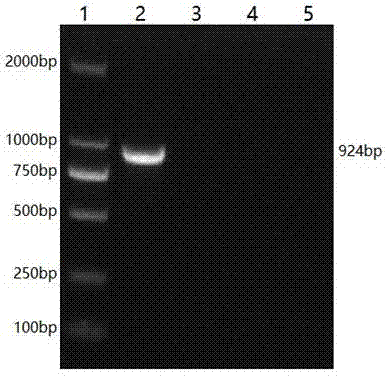Duplex PCR primers for actinobacillus pleuropneumoniae and pasteurella multocida
A porcine pleuropneumonia and actinobacillus technology, applied in microorganisms, recombinant DNA technology, microorganism-based methods, etc., can solve the problems of high morbidity and mortality, difficulty in differential diagnosis, economic losses in the pig industry, etc., and achieve strong specificity. Sex and sensitivity, simple effect
- Summary
- Abstract
- Description
- Claims
- Application Information
AI Technical Summary
Problems solved by technology
Method used
Image
Examples
Embodiment 1
[0017] Example 1 Detection of specificity of primers A1 and A2 of Actinobacillus pleuropneumoniae
[0018] The DNA of App bacteria, DNA of Pm bacteria, DNA of Haemophilus parasuis and DNA of Escherichia coli were extracted as templates for PCR detection.
[0019] Using the extracted DNA of the sample to be tested as a template, the total volume of the PCR reaction of a single pair of primers is 20 μL: add 10 μL of 2×EasyTaq SuperMix, and the concentrations of primers A1 and A2 are both 10 uM Add 1.0 μL each, extract 3 μL of the DNA template of the sample to be tested, and supplement with sterile deionized water to a final volume of 20 μL.
[0020] Specific results such as figure 1 , in which lane 1: DNA Marker DL2000; lane 2: detection of DNA of App bacteria, there is a band at 924bp, indicating that App bacteria is positive; lane 3: detection of DNA of Pm bacteria, no band display, indicating that App bacteria is negative Swimming lane 4: detection of DNA of Haemophilus pa...
Embodiment 2
[0021] Example 2 Detection of the specificity of Pasteurella multocida primers A1 and A2
[0022] The DNA of Pm bacteria, App bacteria DNA, Haemophilus parasuis DNA and Escherichia coli DNA were extracted as templates for PCR detection.
[0023] Using the extracted DNA of the sample to be tested as a template, the total volume of the PCR reaction of a single pair of primers is 20 μL: add 10 μL of 2×EasyTaq SuperMix, and the concentrations of primers P1 and P2 are both 10 uM Add 1.0 μL each, extract 3 μL of the DNA template of the sample to be tested, and supplement with sterile deionized water to a final volume of 20 μL.
[0024] Specific results such as figure 2 , in which lane 1: DNA Marker DL2000; lane 2: detection of DNA of Pm bacteria, a band at 119 bp, indicating that Pm bacteria are positive; lane 3: detection of DNA of App bacteria, no band display, indicating that Pm bacteria are negative Swimming lane 4: detection of DNA of Haemophilus parasuis, no band display, i...
Embodiment 3
[0025] Example 3 Double PCR detects the specificity of App and Pm
[0026] The DNA of App bacteria, DNA of Pm bacteria, DNA of Haemophilus parasuis, DNA of Escherichia coli and sterile deionized water were used as templates for PCR detection.
[0027] The total volume of the double PCR reaction is 20 μL: 10 μL of 2×Easy Taq SuperMix is added, and the concentrations of primers A1 and A2 are both 10 uM Add 1.0 μL each, the concentrations of primers P1 and P2 are both 10 uM Add 0.5 μL each, extract 3 μL of the DNA template of the sample to be tested, and add sterile deionized water to a final volume of 20 μL.
[0028] The reaction conditions were as follows: pre-denaturation at 94 °C for 10 min, followed by cycling, the cycle parameters were 30 sec at 94 °C, annealing at 57 °C for 30 sec, 45 sec at 72 °C, and extension at 72 °C for 10 min after 35 cycles. At the end of the reaction, 5 μL of the PCR reaction product was electrophoresed on a 1% agarose gel, using DNA Marker DL2...
PUM
 Login to View More
Login to View More Abstract
Description
Claims
Application Information
 Login to View More
Login to View More - R&D
- Intellectual Property
- Life Sciences
- Materials
- Tech Scout
- Unparalleled Data Quality
- Higher Quality Content
- 60% Fewer Hallucinations
Browse by: Latest US Patents, China's latest patents, Technical Efficacy Thesaurus, Application Domain, Technology Topic, Popular Technical Reports.
© 2025 PatSnap. All rights reserved.Legal|Privacy policy|Modern Slavery Act Transparency Statement|Sitemap|About US| Contact US: help@patsnap.com



